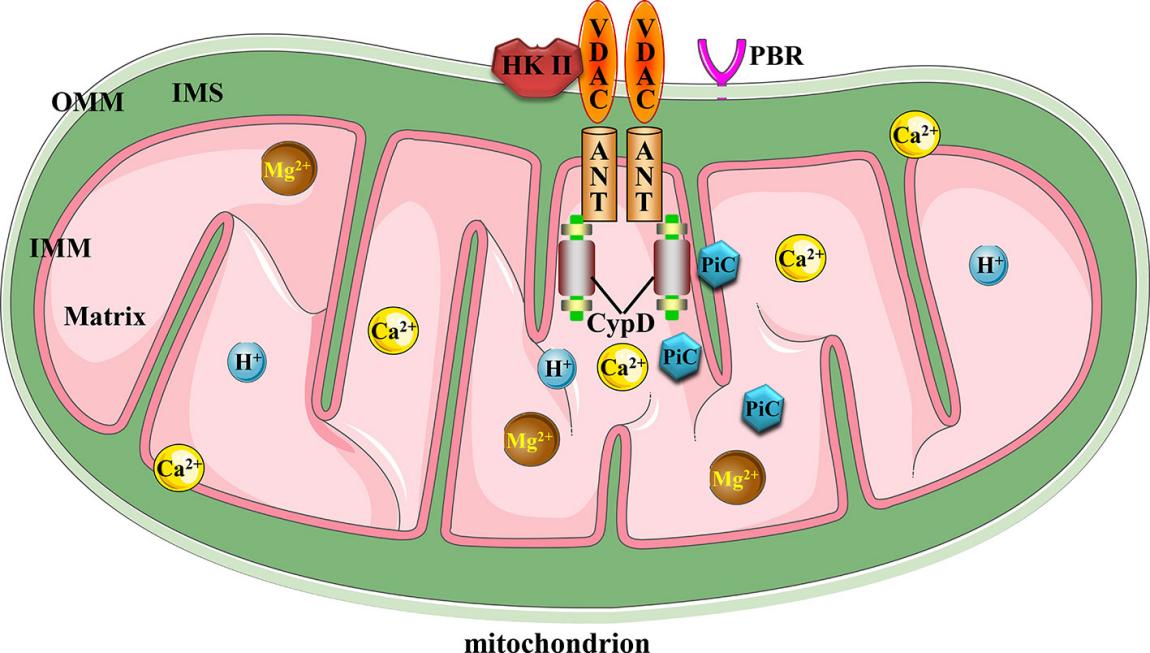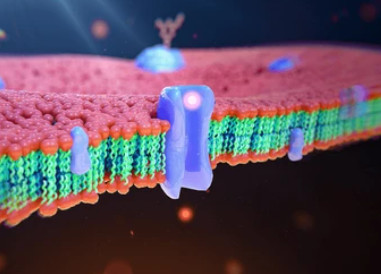Mitochondrial Permeability Transition Pore Analysis
Online InquiryMitochondria are highly dynamic organelles in the body responsible for generating the energy needed for the metabolism of the organism. Mitochondrial damage activates signaling pathways that induce apoptosis. The mitochondrial membrane permeability transition pore (mPTP), also known as the mitochondrial giant channel, is a non-selective, highly conductive channel that spans between the inner and outer mitochondrial membranes and is composed of a complex of proteins. mPTP is a non-specific channel that plays an important role in cell survival and apoptosis in various areas such as tumor, aging, and neurodegeneration. Based on experienced experts and advanced platforms (such as flow cytometry, fluorescence microscopy, and laser confocal microscopy), Creative Proteomics provides mitochondrial permeability transition pore assay services.
 Fig. 1 Canonical
mitochondrial MPTP molecular structure. (Li, Yangxin, et al, 2020)
Fig. 1 Canonical
mitochondrial MPTP molecular structure. (Li, Yangxin, et al, 2020)
Overview of mPTP
In healthy cells, mPTP transitions between open and closed states, but during cell death, mPTP significantly alters mitochondrial permeability. Activation of mPTP is followed by massive mitochondrial swelling, impaired ATP synthesis, Ca2+ accumulation, cytochrome c (Cyt c) release and the loss of mitochondrial membrane potential. Ca2+ is a universal second messenger and plays a critical role in a wide range of cellular processes. Opening of mPTP can be induced by an increase in mitochondrial Ca2+ load. In addition, oxidative stress can also trigger pore opening. mPTP opening can lead to enhanced permeability of the inner mitochondrial membrane (IMM), resulting in membrane rupture, bioenergetic failure, and ultimately cell death. Since the probability of pore opening can be regulated by drugs, it represents a useful pharmacological target for translational studies of drug discovery.
Our mitochondrial permeability transition pore analysis
Calcein is a calcium ion fluorescent indicator with excitation light at 495 nm and emission light at 515 nm. The calcium yellow-green fluorescence is self-suspended when its concentration is greater than 100 mM. Calcein is often used as a complex indicator to titrate calcium ions chelated by EDTA and to determine calcium ion concentrations by fluorescence detection. Based on advanced mitochondrial permeability transition pore assay kits (TMRE multiplexed calcein/cobalt technology), we can simultaneously measure membrane integrity and mitochondrial membrane potential. Our services are primarily based on the robust protocols of mitochondrial isolation and measurements of light scattering or fluorescence measurements.
Workflow of our service
- Mitochondria isolation and purification
- Mitochondrial quality and function assessment
- Preparation of assay buffer
- Addition of reagents and measurement of pore opening
- Data analysis
Sample requirement
- Living Cells
Instrument platform
- Laser confocal microscopy
- Fluorescence microscopy
- Flow cytometry
Advantages of our services
- Cutting-edge technology and advanced platform
- Rich experience in detecting mitochondrial function analysis
- Highly customized mitochondrial permeability transition pore assay
- Rapid turnaround and cost-effective
Creative Proteomics is a leading service provider in mitochondrial function analysis, we are dedicated to providing a range of services, including mitochondrial permeability transition pore assay, mitochondrial oxidative phosphorylation analysis, and mitochondrial membrane potential assay. Welcome to consult for details, we will develop a detailed service agreement according to your program and needs. For more experimental technology services, please browse the rest of our website or contact us.
References
- Bhosale, Gauri, and Michael R. Duchen. "Investigating the mitochondrial permeability transition pore in disease phenotypes and drug screening." Current protocols in pharmacology 85.1 (2019): e59.
- Li, Yangxin, et al. "Mitochondrial MPTP: a novel target of ethnomedicine for stroke treatment by apoptosis inhibition." Frontiers in pharmacology 11 (2020): 352.
Related Services
* For Research Use Only. Not for use in diagnostic procedures.








